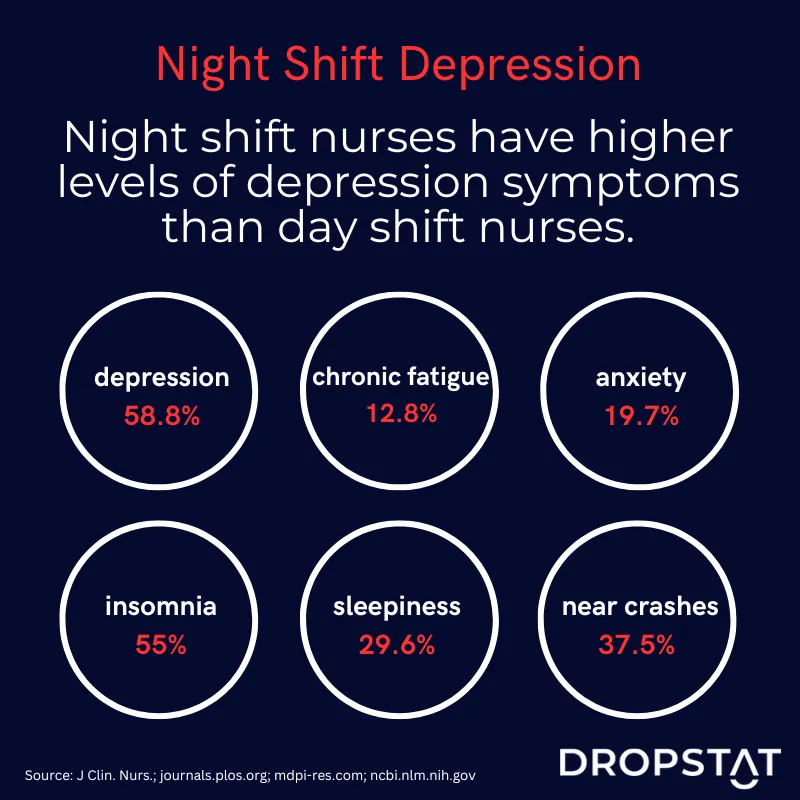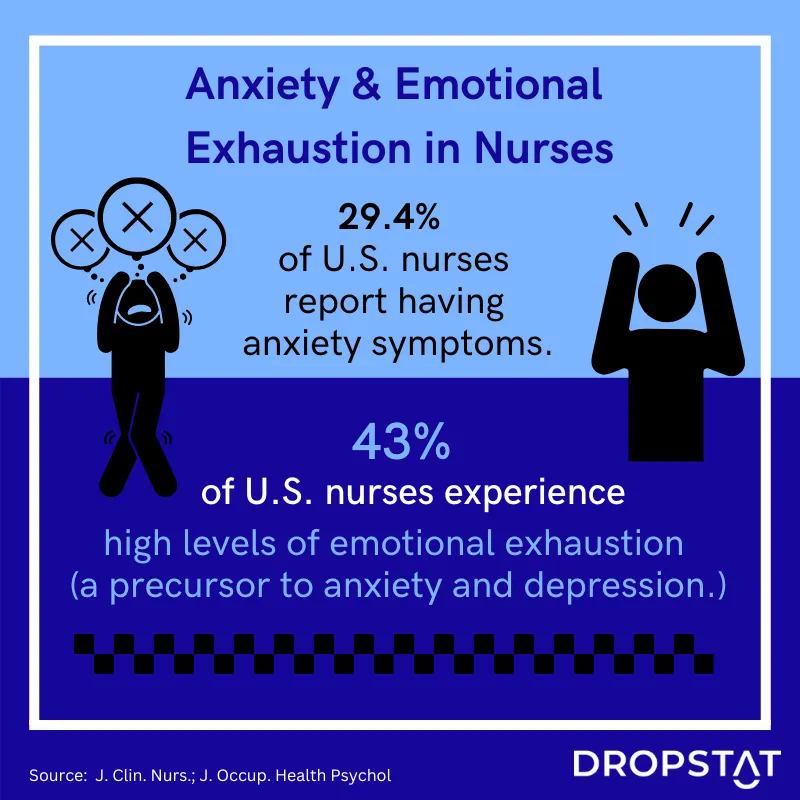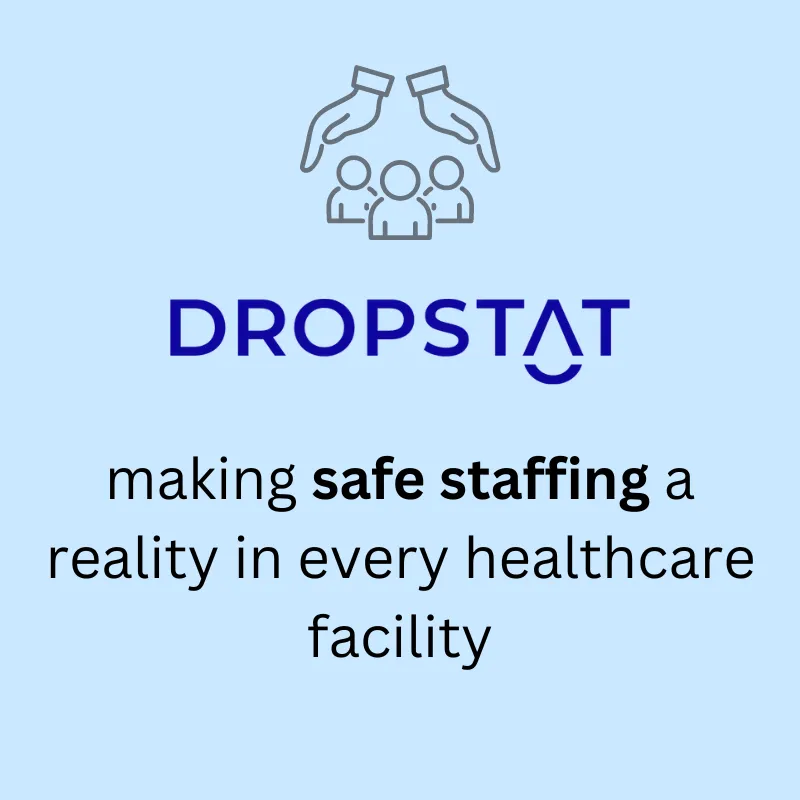Nursing requires nurses to focus on many things at once. The immense pressures in healthcare and multi-tasking may cause depression and anxiety in nurses. Because of this, healthcare managers often struggle with disengaged, anxious, and depressed nurse employees.
What are the main causes of nurse anxiety?
Caring for patients can be stressful, especially with complex cases. Research shows that nurses experience higher levels of anxiety and depression than the general population. A study in the Journal of Clinical Nursing found that up to 40% of nurses report symptoms of depression. Another study in the Journal of Advanced Nursing found that up to 80% of nurses experience high levels of stress.
Here are several factors that cause nurse anxiety and depression:
- High workload and staffing issues: Nurses may experience anxiety due to burnout from high workloads, staffing issues, and insufficient support.
- Patient care responsibilities: Nurses are responsible for the care of their patients; at times, the burden of caring for many patients is overwhelming.
- Long shifts and working the night shift: Long work hours, especially through the night, can be challenging, causing night-shift depression.
- Workplace conflicts: Interpersonal conflicts with colleagues or supervisors can create a negative work environment which leaves nurses feeling down.
- Fear of making mistakes: Nurses are responsible for administering medication and procedures. The fear of making a mistake comes from taking responsibility very seriously.
- Exposure to trauma: Nurses who work in emergency departments, intensive care units, and other high-stress environments experience trauma.
- Financial pressures: Nurses experience financial pressures due to student loans, family responsibilities, or other factors.
- Demanding patients or families: Demanding or difficult patients or their families make nurses anxious.
- New-nurse anxiety: Newly licensed nurses experience pre-shift anxiety and self-doubt as they adjust to their new responsibilities.

The effects of nursing anxiety and depression
Nurse anxiety and depression can have significant consequences for nurses, any healthcare facility, and patients.
Effects of anxiety on nurses:
- Burnout: High levels of anxiety contribute to burnout, which affects job performance and nurse well-being.
- Decreased job satisfaction: Nurses who experience anxiety have lower job satisfaction and job engagement levels.
- Poor sleep quality: Anxiety can make it difficult for nurses to sleep well, which leads to fatigue and exhaustion.
- Physical health issues: Chronic stress and anxiety can lead to physical health problems such as high blood pressure, heart disease, and digestive issues.
- Mental health issues: Anxiety can contribute to nurses’ mental health problems, such as depression from the night shift, panic disorder, and general anxiety disorder.
- Substance abuse: Some nurses use alcohol or drugs to cope with anxiety, which can lead to substance abuse and addiction.
- Career change: Nurses who experience chronic anxiety consider leaving nursing due to anxiety for a less stressful job role. In 2021, 29% of nurses considered leaving nursing.
Effects of nurse anxiety and depression on a facility:
- Decreased efficiency: The efficiency of the healthcare facility will affect its reputation. The facility may see a decrease in patient volume and revenue.
- Increased turnover: Nurses who experience anxiety may be more likely to leave their jobs, leading to increased turnover and higher recruitment and training costs.
- Decreased productivity: Anxiety can contribute to decreased job satisfaction among nurses, which can affect their motivation and engagement at work.
- Increased absenteeism: Nurses who experience anxiety may be more likely to take time off work, which can affect the overall functioning of the healthcare facility. In 2022, anxiety in nurses led to 128,161 working days being lost in one month.
- Reduced patient satisfaction: Patients who receive care from anxious nurses may be less satisfied with the care they receive.
- Increased healthcare costs: Poor quality patient care and adverse events can lead to increased healthcare costs for patients and the healthcare facility.
- Increased liability: Healthcare facilities may be liable for adverse events and errors due to nurse anxiety, with legal and financial consequences.

Effects of nurse anxiety on patients:
- Decreased quality of patient care, leading to errors and mistakes that compromise patient safety.
- Increased risk of adverse events, for example, falls and infections.
- Increased patient anxiety as patients sense the anxiety of their nurse.
- Decreased patient experience as patients who receive care from anxious nurses may be less satisfied with their overall experience.
- Delayed care as anxious nurses may be slower to respond to patient needs, leading to potential delays in care.
- Decreased communication as poor communication between nurses and patients leads to misunderstandings and mistakes.
- Increased length of stay as nurses with anxiety causes longer hospital stay for patients.
10 ways to identify nurse anxiety
When managers address the root causes of nurse anxiety and depression, nurses will become more engaged and productive. This begins with exposing the problem.
Here are ten ways nurse managers can identify anxiety and depression among nurses:
- Regular check-ins: to discuss any concerns nurses may have.
- Observation: Managers can look for changes in behavior or demeanor.
- Self-reporting: Encouraging nurses to self-report feelings of anxiety or depression.
- Staff surveys: Conduct staff surveys that include questions about mental health.
- Absenteeism and tardiness: These may be indicators of anxiety or depression.
- Quality of work: A decrease in the quality of work may be a sign of anxiety or depression.
- Interpersonal conflicts: Nurses with anxiety or depression have more conflicts with their colleagues. Conflict can be a sign that nurses are struggling.
- Physical symptoms: Headaches, fatigue, and gastrointestinal issues may be indicators of anxiety or depression.
- Changes in mood: Irritability or mood swings may indicate anxiety or depression.
- Feedback from colleagues: Colleagues may notice changes in behavior or mood among their fellow nurses and can provide feedback to managers.#

Strategies to support nurses with anxiety and depression
Healthcare managers can address nurse anxiety and depression with proactive steps to support the nurses. This will improve patient outcomes, increase employee engagement and productivity, and improve the facility’s reputation.
Here are some strategies to address nurse anxiety and depression:
- Create a positive work environment by offering encouragement, opportunities for growth and development, and rewarding excellent performance.
- Provide mental health support, including access to counseling, a helpline, and an in-house listening ear.
- Offer flexibility in scheduling where possible by allowing nurses to choose shifts, reducing the number of night shifts, and offering the option to work part-time or on a per diem basis.
- Provide training to manage stress and anxiety. This can include teaching stress management techniques, time management, and effective communication courses.
- Address workload and staffing issues by hiring additional staff, reducing the number of patients per nurse, and ensuring that nurses have the necessary resources and support.
- Foster an organizational culture of support, promoting teamwork and collaboration – such as with Dropstat’s gratitude feed – opportunities for nurses to give and receive feedback.
- Improvements within an organization for clearer communication about work schedules make nurses’ shifts predictable, which helps nurses feel secure.
How Dropstat can help prevent nurse anxiety
Dropstat’s AI-powered staff scheduling app ensures that all shifts meet the required staff-to-patient ratios with the requirements for each discipline. This ensures that staff members are not overworked and exhausted from carrying out a too-heavy patient load – often a great cause of nurse anxiety, poor mental health, and work disengagement.
Dropstat also allows nurse managers to schedule shifts well in advance. This helps to reduce nurse anxiety that comes from factors such as not knowing the upcoming work schedule, vacation schedule, or fear of having to work overtime. Schedule a demo now to take advantage of Dropstat’s strategic staff scheduling platform and start making your facility a safer and more pleasant place to work in.

FAQ’s
What is new nurse anxiety?
Every new job brings some anxiety with it, but nurses are often thrown in at the deep end. It can be overwhelming for new nurses to learn new characteristics of a hospital and struggle to please their employees and their patients and look after themselves. One way nurse employers can help new nurses not feel so lonely and intimidated is to hook them up with a friendly colleague for support and to supply mental health options for all new nurses.
What is a pre-night shift anxiety attack?
Pre-shift anxiety is the fear that nurses may feel before a shift begins. It is also known as anticipatory anxiety, which comes from not knowing which challenges will crop up and whether the nurse will succeed in the upcoming shift. It is especially common before the night shift, possibly due to low levels of serotonin (a sleep hormone).
A nurse may experience intense panic, fear, and physical symptoms such as shortness of breath, pain in the chest, and palpitations. Nurse managers should encourage night shift workers to be on time for the shift, for a structured and full handoff session, and to be familiar with the rest of the team they will be working with. Nurse managers should also suggest to night shift nurses ways to have a healthy work-life balance and get enough sleep.
How many nurses are leaving nursing due to anxiety?
Many nurses enter the nursing profession hoping to help people, but the stress and pressure cause them to develop depression and anxiety. This makes many nurses change their minds and quit their nursing careers. Since 2021, 95% of nurses have reported feeling burnt out. Up to 30% of all US nurses quit their jobs in 2021. 90% of nurses surveyed by Hospital IQ in 2021 considered leaving in the year to come. 71% of nurses with over 15 years of experience wanted to leave as soon as possible.
The hope is that technology can help lessen burnout with greater transparency into patient needs, better communication, and being represented to hospital leadership more effectively.
What is the link between working the night shift and depression?
A Hospital IQ 2021 report revealed that 39% of nurses experienced serious mental health issues, including anxiety and depression, while working regular shifts. The risk of nurse depression and mood disorders increases when nurses work the night shift. Lack of regular sleep patterns causes fatigue and an accompanying lack of judgment, irritability, reduced cognitive abilities, and poor focus. Research suggests that nurses who work at night are 33% more likely to suffer from depression than nurses who work on a daytime schedule.







